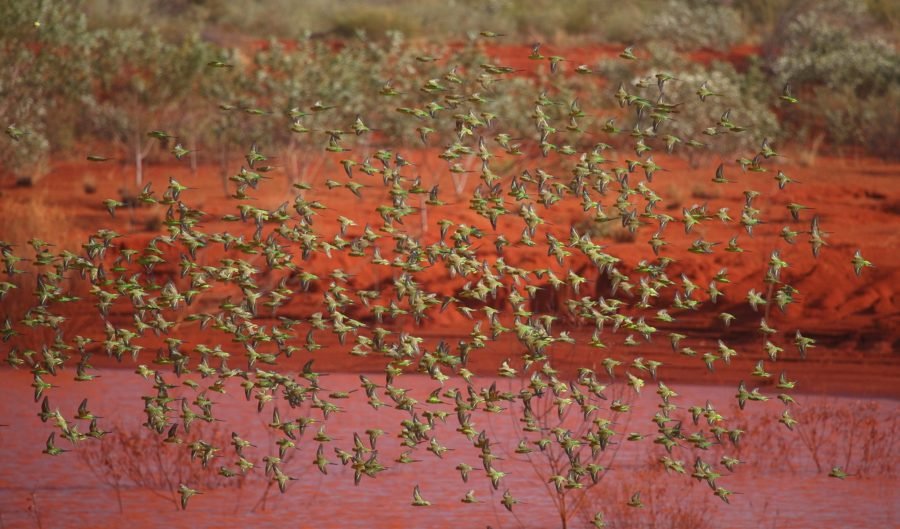Desert nomads: 4 things you didn’t know about budgies

AUSTRALIA’S NATIVE budgerigars have bright feathers, and even brighter personalities. They can be heard loudly chattering in large green flocks, making their way across the Australian outback in search of water.
Up to 4000 birds can be seen congregating around a single waterhole in the hot, dry summer months in Alice Springs. The event has attracted photographers from around the world, who are eager to get a glimpse of the phenomenon.
Wild budgies, however, are very different from their captive counterparts, with which you may be more familiar. Budgie breeders have spent years tweaking the birds’ genes, giving them violet and blue feathers – popular colours among pet owners.
Here are a few things you may not know about these incredibly well-adapted Aussie birds.
1. They’re desert nomads
Budgies are well adapted to surviving in the harsh Australian outback, their natural habitat. In fact, they actually have a specific physiological function to cope with the extreme heat and they can go weeks without drinking water.
In a study published last year, scientists placed budgies in a simulated nest box overnight where levels of humidity were alternated.
They found that the birds were regulating evaporative water loss, possibly by changing the temperature of the air they breathe out or changing the evaporative water loss through their skin.
2. They helped Indigenous Australians locate water
That large green flocks of budgies are easily spotted against the red plains of the outback and are in constant search of water, allowed Indigenous Australians to use the bird to track sources of water.
According to David Roth of the Japingka Gallery in Western Australia, the Warlpiri people in the Northern Territory have a Dreaming story about how the budgies helped them locate critical waterholes. Other stories say the bird and their eggs were eaten as delicacies.
The budgie is very much revered in Aboriginal culture and has been depicted in a number of contemporary artworks, including by Lindsay Corby, Karen Barnes and Lorraine Granites in an exhibition Budgerigar Dreaming.
3. Their natural colours are green and yellow
Wild budgies are only ever yellow and green. Those that are bred in captivity, however, often have a mixture of yellow, lime green, violet and blue feathers. It’s been estimated that there are over 30 possible colour variations. The first recorded colour variation occurred in 1870.
In a paper published in late 2017 in the journal Cell, scientists found a previously unidentified gene that synthesized the budgies’ yellow pigments, revealing for the first time how budgies get their colour.
4. They’re world record holders
Budgies are incredibly talkative, so much so that in 1995 one particular bird made the Guinness World Records.
A male budgie called Puck still holds the world record for the biggest vocabulary of any bird, at a whopping 1,728 words.
And that isn’t the first time they achieved world recognition for their vocals. Who could forget Disco? The budgie with its very own (highly successful) YouTube channel that mimicked lines from Monty Python and Dirty Dancing.

